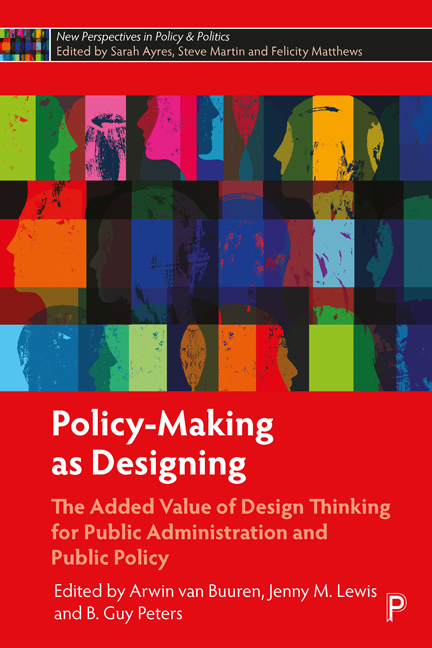 Policy-Making as Designing
Policy-Making as Designing Book contents
- Frontmatter
- Contents
- List of figures and tables
- Notes on contributors
- 1 Improving public policy and administration: exploring the potential of design
- 2 Applying design in public administration: a literature review to explore the state of the art
- 3 Challenges in applying design thinking to public policy: dealing with the varieties of policy formulation and their vicissitudes
- 4 Designing environments for experimentation, learning and innovation in public policy and governance
- 5 Policy Labs: the next frontier of policy design and evaluation?
- 6 When design meets power: design thinking, public sector innovation and the politics of policy-making
- 7 Designing institutions for designing policy
- 8 Applying design science in public policy and administration research
- 9 Using a design approach to create collaborative governance
- 10 Policy-making as designing: taking stock and looking forward
- Index
8 - Applying design science in public policy and administration research
Published online by Cambridge University Press: 20 January 2024
- Frontmatter
- Contents
- List of figures and tables
- Notes on contributors
- 1 Improving public policy and administration: exploring the potential of design
- 2 Applying design in public administration: a literature review to explore the state of the art
- 3 Challenges in applying design thinking to public policy: dealing with the varieties of policy formulation and their vicissitudes
- 4 Designing environments for experimentation, learning and innovation in public policy and governance
- 5 Policy Labs: the next frontier of policy design and evaluation?
- 6 When design meets power: design thinking, public sector innovation and the politics of policy-making
- 7 Designing institutions for designing policy
- 8 Applying design science in public policy and administration research
- 9 Using a design approach to create collaborative governance
- 10 Policy-making as designing: taking stock and looking forward
- Index
Summary
Introduction
Governments around the world are struggling to find innovative solutions for complex problems. Key issues are sustainability, the quality of living in cities, and inequalities and tensions between groups of citizens. To address these challenges, new forms of governance are needed which serve to make and implement collectively binding decisions that take into account the interests of all those affected, including future generations. Institutions for public governance and policy-making are, in their present form, often not up to the task. As a result, democratic and administrative bodies tend to respond to major problems and challenges using yesterday's tools (Shkliarevsky, 2016; OECD, 2017; Zhang and Feeney, 2018).
There is a growing debate about the role of academic researchers in governments’ responses to these challenges. The vast majority of public policy and administration scholars focus on describing and explaining how existing governance systems operate, but the need to engage in experimentation, interventions and other efforts to actually change (the conditions of) these systems is increasingly emphasised. Several scholars have therefore been advocating a fundamental rethink of the ‘bystander’ character of much research in the area of political science and public governance (for example, Ricci, 1984; Gunnell, 2004; Ansell, 2011; Schram et al, 2013). Accordingly, public policy and administration (PPA) research would need to be driven by extant theories and methods as well as be framed around pressing public issues and dilemmas in the real world (Smith, 2002; Shapiro, 2005; Schram et al, 2013; Buick et al, 2016).
In this chapter, we contribute to this discourse by developing a design approach for PPA that integrates retrospective research (validation) and prospective research (design). We thus not only build on ‘conventional’ approaches to studying governance (for an overview, see Levi-Faur, 2012) but also on design science. The notion of design science (DS) arises from Simon's (1969) seminal work, and has been gaining momentum in fields such as information systems (for example, March and Smith, 1995), organisation studies (for example, Romme, 2003), and public policy and administration (for example, Shangraw and Crow, 1989; Considine, 2012; Bason, 2016; Ansell et al, 2017; Chapter 1, this volume).
- Type
- Chapter
- Information
- Policy-Making as DesigningThe Added Value of Design Thinking for Public Administration and Public Policy, pp. 171 - 190Publisher: Bristol University PressPrint publication year: 2023


